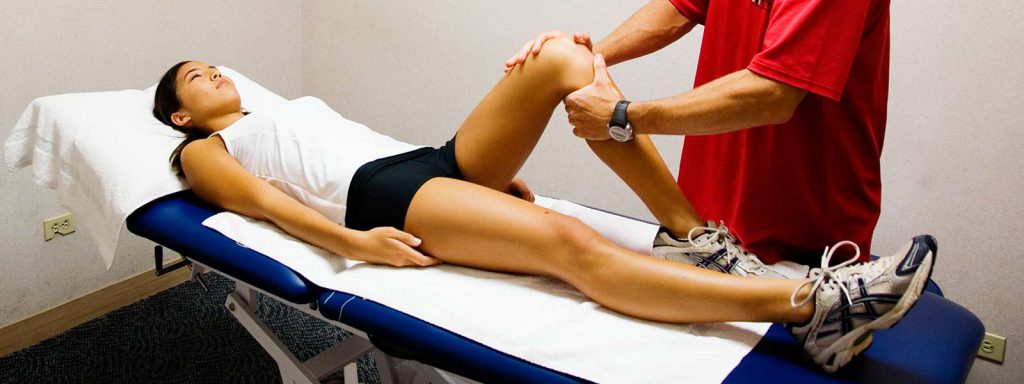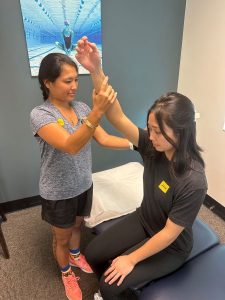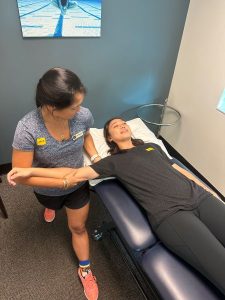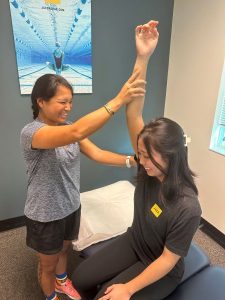
You’re new to physical therapy for pain and stiffness in your shoulder. You’ve tried stretching independently, but the joint feels “stuck.”
In an outpatient setting like JACO Rehab, your physical therapist will utilize a variety of techniques to help alleviate and resolve your pain and stiffness. This can range from stretching and strengthening exercises to manual interventions, such as soft tissue work. Physical therapists may also choose to perform joint mobilizations to encourage more mobility in your joint, which helps you move better.
But what is a joint mobilization? And more importantly, will it hurt? Will your physical therapist “break” anything? Is this like going to a chiropractor? Here’s what to expect.
What is Joint Mobilization?
Joint mobilization techniques are utilized by your physical therapist with the intention to “stretch out” your joint capsule. This type of manual intervention encourages the normal rolling and sliding of your joint, smoothing out the movement to allow for pain-free motion.
This is a passive intervention, which means your physical therapist will perform it while you relax. They may vary the amount of pressure they apply or the angle of their approach. The goal is to improve tolerance for independent stretching with less pain, which may reduce any fear around movement.
Why are Joint Mobilizations Useful?
Joint mobilizations are helpful in creating joint space or improving the joint’s “stiffness.”
For those with painful joint conditions like arthritis, certain joint mobilization techniques may feel relieving because it creates more space between the two joint surfaces. Some conditions of the shoulder, like impingement, may also feel similar relief this way, although it’s temporary.
Stiffness in your joint can occur post-operatively, in response to injury and inflammation, or with prolonged lack of movement. When a joint gets stiff, its movement is restricted by roadblocks, like excess fluid, tight surrounding tissues (like the joint capsule in a frozen shoulder), or even bony structures like a spur. Some of these issues benefit from joint mobilization to encourage correct movement in the joint, so long as your therapist deems it appropriate.
What Do I Expect From Joint Mobilizations
Physical therapists apply joint mobilizations in varying intensities and directions depending on their intention. Most mobilizations involve your therapist providing a distracting (space-creating) force to the affected joint, then moving the joint surfaces using techniques to encourage more movement and relieve pain.
You may feel pressure around the joint or at the spot where your therapist’s hand is making contact. But most times, joint mobilizations are pain-free and should provide a “stretchy” or “relieving” sensation. Your physical therapist may combine joint mobilization with passive limb movement to gain more mobility, like the image series below.
Does It Feel Like the Chiropractor?
Joint mobilizations are aimed at creating space and movement between the two surfaces in a joint. They are not to be confused with a high-velocity manipulation or thrusts that “crack” the joint like many see from a chiropractor. Although those techniques have their place, it’s not the same as joint mobilization.
Will I Always Need Joint Mobilizations?
At JACO Rehab, your physical therapist may spend anywhere from 15–40 minutes on manual interventions that include joint mobility, depending on whatever is deemed necessary and beneficial. But the goal is to reduce time on manual interventions and progress your treatment plan to more active tasks that involve stretching and strengthening with the therapist’s guidance, and eventually, on your own.
As you progress, you may have sessions where you don’t receive any hands-on treatment. Instead, the sessions are focused on your own movements and form as you prepare for graduation from physical therapy.
Reach out!
We hope this helps you better understand what your physical therapist is doing when they are performing “joint mobilizations” during treatment! We’re excited to help initiate your rehab journey! If you have any further questions, don’t hesitate to reach out to JACO Rehab at 808-381-8947.
Written by Kristen Shimabukuro, DPT


